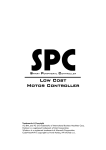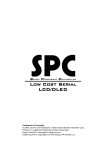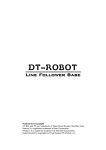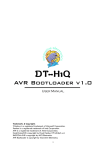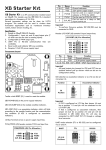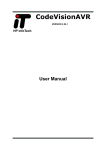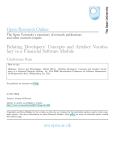Download Neo Stepper Motor 1.2A - Innovative Electronics
Transcript
Smart Peripheral Controller Neo Stepper Motor 1.2A Trademarks & Copyright AT, IBM, and PC are trademarks of International Business Machines Corp. Pentium is a registered trademark of Intel Corporation. Windows is a registered trademark of Microsoft Corporation. CodeVisionAVR is copyright by Pavel Haiduc, HP InfoTech s.r.l. Table Of Contents 1 Introduction............................................................................................... 1.1 SPC NEO STEPPER MOTOR 1.2A Specification.................................. 1.2 Suggested System...................................................................................... 3 3 3 2 SPC NEO STEPPER MOTOR 1.2A Hardware............................................. 2.1 SPC NEO STEPPER MOTOR 1.2A Component Layout........................ 2.2 Connectors and Jumpers Configurations............................................... 3 3 4 3 SPC NEO STEPPER MOTOR 1.2A Interface............................................... 3.1 UART TTL Interface..................................................................................... 3.2 I2C Interface................................................................................................ 3.3 Command Set.............................................................................................. 3.3.1 Continuous Run............................................................................................ 3.3.2 Pulse Count Run........................................................................................... 3.3.3 Brake............................................................................................................. 3.3.4 Stop............................................................................................................... 3.3.5 Set I2C Address........................................................................................... 3.3.6 Read I2C Address....................................................................................... 6 6 6 7 7 8 9 9 10 10 4 Testing Procedure..................................................................................... 11 5 Application and Program Example.......................................................... 11 Attachment A. SPC NEO STEPPER MOTOR 1.2A Schematics...................................... 2 13 1. INTRODUCTION Smart Peripheral Controller / SPC NEO STEPPER MOTOR 1.2A is a stepper motor controller module which is compact, reliable, and compatible for robotic applications. This module can be used to control the direction and speed of 1 stepper motor using full-step or half-step. This module is equipped with UART TTL and I2C interfaces so that it can easily be connected with other systems. 1.1. SPC NEO STEPPER MOTOR 1.2A SPECIFICATION SPC NEO STEPPER MOTOR 1.2A specification is as follows: • The module requires 4.8 – 5.4 VDC power supply. • The motor requires 2.5 – 13.5 VDC power supply. • Uses a TB6612FNG motor driver IC. • The driver's maximum continuous current is 1.2 A. • Can be used for unipolar or bipolar stepper motors. • Input/Output pins are compatible with TTL and CMOS voltage level. • Equipped with UART TTL and I2C interface. • Using I2C, SPC NEO STEPPER MOTOR 1.2A can be cascaded up to 8 modules. • Module uses a 16 pins 600mil DIP connector configuration which is easier to connect directly to project board or PCB matrix. 1.2. SUGGESTED SYSTEM Suggested system for SPC NEO STEPPER MOTOR 1.2A is as follows: Hardware: • PC™ AT™ Pentium® IBM™ Compatible with USB port. • DT-AVR Low Cost Series. • DVD-ROM Drive and Hard disk. Software: • Windows® XP Operating System. • CodeVisionAVR©. • program CD/DVD contents: Folder contoh_i2c, folder contoh_uart, TB6612FNG.pdf, dan SPC Neo Stepper Motor 1.2A Manual.pdf. 2. SPC NEO STEPPER MOTOR 1.2A HARDWARE 2.1. SPC NEO STEPPER MOTOR 1.2A COMPONENT LAYOUT 3 2.2. CONNECTORS AND JUMPERS CONFIGURATIONS INTERFACE PORT (J2) connector functions as a connector for module power supply input, UART TTL, and I2C interface. Pin Name Function 1,2 VIN Connected to power supply (4.8 – 5.4 Volts) 3 SCL I2C-bus clock input 4 SDA I2C-bus data input / output 5 RX TTL TTL serial level input to SPC module 6 TX TTL TTL serial level output from SPC module 7,8 PGND Ground reference for SPC module power supply MOTOR (J3) connector functions as a connector for motor power supply input and motors. Pin Name Function 1,2 VM Connected to motor power supply (2.5 – 13.5 Volts) 3 M11 1st Output from H-Bridge M1 pair 4 M12 2nd Output from H-Bridge M1 pair 5 M21 1st Output from H-Bridge M2 pair 6 M22 2nd Output from H-Bridge M2 pair 7,8 MGND Ground reference for motor power supply Pay attention to the type of stepper motor connected to SPC NEO STEPPER MOTOR 1.2A because each type has its own connection. SPC NEO STEPPER MOTOR 1.2A can be utilized for 3 types of stepper motor: Bipolar, 5 cables Unipolar, and 6 cables Unipolar. The following are the connection examples for each stepper motor type: Bipolar Konektor J3 2,5V-13V M A B VM M11 M12 M21 C M22 MGND D Ground Catu Daya Motor 4 Unipolar 5 kabel Konektor J3 2,5V-13V VM A M M11 M12 B M21 M22 C MGND D Ground Catu Daya Motor COMMON Unipolar 6 kabel Konektor J3 2,5V-13V VM A M M11 M12 B M21 M22 C MGND D Ground Catu Daya Motor COMMON 1 COMMON 2 SCL-SDA (J4) jumpers are used to activate pull-up resistors for SDA and SCL on I2C interface. Jumper SCL-SDA J4 Function Pull-up inactive (jumpers disconnected) SCL SDA Pull up active (jumpers connected) SCL SDA 5 Important! If more than one module is connected to I2C-bus, then only one set of SCLSDA (J4) jumpers needs to be connected. I2C address configuration can be done through UART TTL interface. LED M1 IND (D3) and M2 IND (D4) function as stepper motor condition indicator (direction, condition, or pulse indicator). 3. SPC NEO STEPPER MOTOR 1.2A INTERFACE SPC NEO STEPPER MOTOR 1.2A has UART TTL and I2C interfaces that can be used to receive commands or send data. 3.1. UART TTL INTERFACE UART TTL communication parameters are as follows: • 38400 bps • 8 data bits • 1 stop bit • no parity bit • no flow control All commands sent through UART TTL interface begin with 1 byte data that contains <command number>, followed by (if needed) n-byte data command parameter. If the command sent is a command requesting data from the SPC NEO STEPPER MOTOR 1.2A module, then SPC NEO STEPPER MOTOR 1.2A will send the data via TX TTL line. A data parameter that has a range larger than 255 decimals (larger than 1 byte) will be sent in two steps. 1 byte MSB data is sent first and is followed by LSB data. For example: parameter <pulse delay> which has a range of 1 65535. If <pulse delay> has a value of 1500 then MSB byte will be 5 and LSB byte will be 220 ((5x256)+220=1500). Available commands and parameters can be seen in section 3.3. 3.2. I2C INTERFACE SPC NEO STEPPER MOTOR 1.2A module has a I2C interface. In this interface, SPC NEO STEPPER MOTOR 1.2A module acts as a slave with an address that has been determined via UART command (see section 3.3.5). I2C interface on SPC NEO STEPPER MOTOR 1.2A module supports bit rate up to a maximum rate of 50 kHz. All commands sent through I2C interface begin with start condition, followed by 1 byte of SPC NEO STEPPER MOTOR 1.2A module address. After the address is sent, the master must send 1 byte data that contains <command number>, followed by (if needed) n-byte command parameter data. After all command parameters have been sent, the command is ended with stop condition. 6 The following is the sequence that must be done to send a command via I 2C interface. Start 1 + 1 1 0 X X X 0 + X X X Write Address X X X X X X X X + Command X X X X X + Parameter (if available) Stop A data parameter that has a range larger than 255 decimals (larger than 1 byte) will be sent in two steps. 1 byte MSB data is sent first and is followed by LSB data. For example: parameter <pulse delay> which has a range of 1 65535. If <pulse delay> has a value of 1500 then MSB byte will be 5 and LSB byte will be 220 ((5x256)+220=1500). Available commands and parameters can be seen in section 3.3. 3.3. COMMAND SET The following is a complete list of commands on UART and I2C interface: 3.3.1. CONTINUOUS RUN Function Command Parameter Controls stepper motor so that it rotates continuously 0x30 <step type> 1 Full-Step: motor will rotate 1 step every 1 pulse 2 Half-Step: motor will rotate ½ step every 1 pulse <direction> 0 motor will rotate clockwise 1 motor will rotate counter clockwise Response Description <pulse delay> 1 - 65535 Delay time between pulse to stepper motor. The smaller the pulse delay, the faster the stepper motor rotates ● If parameter <direction> has a value of 0, then M1 indicator LED will lit up red. ● If parameter <direction> has a value of 1, then M1 indicator LED will lit up green. ● If the stepper motor rotates to an opposite direction, then it means that the connection is reversed. To fix it, change the order of connection installation. ● Each time 1 step pulse is given, then M2 indicator LED will change from red to green or green to red (if the pulse delay is small enough, M2 indicator LED will lit up orange). ● One pulse delay value represents delay time between pulse for about 1 ms. 7 Example with UART interface to run the stepper motor so that it rotates clockwise continuously, with a full-step step type, and the delay between pulse is about 100 ms (0x0064 hexadecimal): User : 0x30 0x01 0x00 0x00 0x64 The following is a pseudo code example, to use this command with I2C interface (I2C address example = 0xE0): i2c_start(); i2c_write(0xE0); i2c_write(0x30); i2c_write(0x01); i2c_write(0x00); i2c_write(0x00); i2c_write(0x64); i2c_stop(); // // // // // // // // Start Condition Write to SPC Neo Stepper Motor module “Continuous Run” command Step type Direction MSB pulse delay LSB pulse delay Stop Condition 3.3.2. PULSE COUNT RUN Function Command Parameter Controls stepper motor so that it rotates according to how many steps given 0x31 <step type> 1 Full-Step: motor will rotate 1 step every 1 pulse 2 Half-Step: motor will rotate ½ step every 1 pulse <direction> 0 motor will rotate clockwise 1 motor will rotate counter clockwise <pulse delay> 1 - 65535 Delay time between pulse to stepper motor. The smaller the pulse delay, the faster the stepper motor rotates Response Description <pulse count> 1 - 65535 the number of pulse sent to stepper motor ● If parameter <direction> has a value of 0, then M1 indicator LED will lit up red. ● If parameter <direction> has a value of 1, then M1 indicator LED will lit up green. ● If the stepper motor rotates to an opposite direction, then it means that the connection is reversed. To fix it, change the order of connection installation. ● Each time 1 step pulse is given, then M2 indicator LED will change from red to green or green to red (if the pulse delay is small enough, M2 indicator LED will lit up orange). ● One pulse delay value represents delay time between pulse for about 1 ms. ● After the number of pulse that has been released matches the pulse count, stepper motor will automatically stop (on brake condition) while still maintaining motor torque (current is still flowing through stepper motor coils). 8 Example with UART interface to run the stepper motor so that it rotates clockwise 20 pulses (0x0014 hexadecimal) with a full-step step type, and the delay between pulses is about 1000 ms (0x03E8 hexadecimal): User : 0x31 0x01 0x00 0x03 0xE8 0x00 0x14 The following is a pseudo code example, to use this command with I2C interface (I2C address example = 0xE0): i2c_start(); i2c_write(0xE0); i2c_write(0x31); i2c_write(0x01); i2c_write(0x00); i2c_write(0x03); i2c_write(0xE8); i2c_write(0x00); i2c_write(0x14); i2c_stop(); // // // // // // // // // // Start Condition Write to SPC Neo Stepper Motor module “Pulse Count Run” command Step type Direction MSB pulse delay LSB pulse delay MSB pulse count LSB pulse count Stop Condition 3.3.3. BRAKE Function Command Parameter Response Description Stops the stepper motor while still maintaining motor torque (current is still flowing through stepper motor coils). 0x32 ● This command can be given after the Continuous Run command. ● On brake condition, stepper motor will stop while still maintaining motor torque (current is still flowing through stepper motor coils). ● On brake condition, M1 and M2 indicator LEDs will lit up according to the last Run command. Example with UART interface: User : 0x32 The following is a pseudo code example, to use this command with I2C interface (I2C address example = 0xE0): i2c_start(); i2c_write(0xE0); i2c_write(0x32); i2c_stop(); // // // // Start Condition Write to SPC Neo Stepper Motor module “Brake” command Stop Condition 3.3.4. STOP Function Command Parameter Response Description Stops the stepper motor (current doesn't flow through stepper motor coils) 0x33 ● This command can be given after Continuous Run, Pulse Count Run, or Brake command. ● On stop condition, stepper motor will stop and there will 9 be no current flowing through the motor coils. On stop condition, M1 and M2 indicator LEDs lit up orange. Stop condition is the default condition when the SPC module is powered on. ● ● Example with UART interface: User : 0x33 The following is a pseudo code example, to use this command with I2C interface (I2C address example = 0xE0): i2c_start(); i2c_write(0xE0); i2c_write(0x33); i2c_stop(); // // // // Start Condition Write to SPC Neo Stepper Motor module “Stop” command Stop Condition 3.3.5. SET I2C ADDRESS Function Command Parameter Response Description Changes I2C address 0x41 <0xAA> <0x55> <newAddress> ● This command can only be performed via UART communication line. 2 ● SPC module will use the new I C address after going through power off sequence. 2 ● The allowed I C address <newAddress> can be seen in the table below. 2 ● If the new address given is incorrect, then the I C address will not be changed (the previous address will be used). 2 ● The default I C address is 0xE0. 2 ● I C address data will be saved in EEPROM so it won't be erased when it's powered off. I2C Address I C Write Address I2C Read Address 0xE0 0xE1 0xE2 0xE3 0xE4 0xE5 0xE6 0xE7 0xE8 0xE9 0xEA 0xEB 0xEC 0xED 0xEE 0xEF 2 Example with UART interface to change the I2C address from 0xE0 to 0xE2: User : 0x41 0xAA 0x55 0xE2 3.3.6. READ I2C ADDRESS Function Command Parameter Response Reads the current I2C address 0x42 <I2CAddress> 10 Description ● ● ● This command can only be performed via UART communication line. SPC module's I2C address can also be seen through the number of blinks of the indicator LED when the module is powered on. If the I2C address is 0xE0 then the indicator LED will blink green once. If the I 2C address is 0xE2 then the indicator LED will blink green twice. If the I 2C address is 0xE4 then the indicator LED will blink green 3 times, and so on until I2C address 0xEE at which the indicator LED will blink green 8 times. Example with UART interface: User SPC Module : : 0x42 <I2CAddress> 4. TESTING PROCEDURE 1. Connect the 5 Volts power supply to VIN and VM SPC NEO STEPPER MOTOR 1.2A module. 2. After the indicator LED blinks green according to I2C address, M1 and M2 indicator LEDs will lit up orange. 3. Send “Pulse Count Run” command as shown on the example in section 3.3.2 via UART TTL interface. 4. M1 indicator LED will lit up red and M2 indicator LED will change from red to green or green to red 10 times. 5. If the voltage is measured between pin M11 and M12 when M2 indicator LED is blinking, then the results will alternate between +VM and -VM. 6. If the voltage is measured between pin M21 and M22 when M2 indicator LED is blinking, then the results will alternate between +VM and -VM. 5. APPLICATION AND PROGRAM EXAMPLE As an application example, SPC NEO STEPPER MOTOR 1.2A is used to run a motor stepper with I2C or UART interface. DT-AVR Low Cost Micro System (LCMS) module with ATmega8535 microcontroller is used as master that sends commands. The following are the connections between the modules: VM (2.5V – 13.5V ) M M11 M12 M21 M22 VIN (+5 V ) SPC NEO STEPPER MOTOR 1.2A (address 0xE0) MGND (Motor Power Supply Ground) SDA SDA (PORTD.2) SCL SCL (PORTD.3) PGND (Digital Power Supply Ground) 11 DT-AVR LCMS VM (2.5V – 13.5V ) M M11 M12 M21 M22 VIN (+5 V ) SPC NEO STEPPER MOTOR 1.2A (address 0xE0) MGND (Motor Power Supply Ground) TXD RX (PORTD.0) RXD TX (PORTD.1) DT-AVR LCMS PGND (Digital Power Supply Ground) As an example program for the above application, there are two programs named contoh_i2c.c and contoh_uart.c (included in the CD/DVD) written using CodeVisionAVR 1.25.2 evaluation. In the program, DT-AVR LCMS will send "Continuous Run" command to SPC module (for example, SPC's I2C address is 0xE0) so that the motor stepper rotates clockwise with 500 ms delay between pulses. After the command is sent, DT-AVR LCMS will wait for 5000 ms. Afterward "Brake" command will be sent to SPC followed by another 5000 ms delay. Then DT-AVR LCMS will send "Continuous Run" command to SPC module (for example, SPC's I2C address is 0xE0) so that the motor stepper rotates counter clockwise for 10 pulses with 250 ms delay between pulses. This command is also followed by a 5000 ms delay. The program ends with DT-AVR LCMS sending "Stop" command to the SPC module. ♦ Thank you for your confidence in using our products, if there are difficulties, questions, or suggestions regarding this product please contact our technical support: [email protected] 12 ATTACHMENT A. SPC NEO STEPPER MOTOR 1.2A Schematics 13













